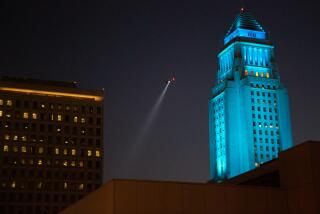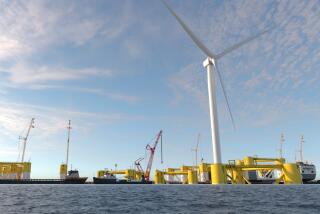Official Questions Report’s Conclusions on Gas Terminal
- Share via
The Long Beach police official assigned to study a proposed liquefied natural gas terminal at the city’s port raised questions Thursday about the conclusions in a draft report that determined the plant would not pose a significant risk.
“It could in fact be safe. It’s just not articulated in the report how they got there,” said Deputy Police Chief Tim Jackman.
Jackman said in an interview Thursday that he attempted to test the calculation used in the report that the probability of a terrorist attack on the terminal is 7 in 1 million.
“I came up with an answer that was so radically different that it made me question the assumptions they were making,” he said.
Nearly 100 people attended the final public hearing Thursday night on the 700-page draft environmental report prepared by the Port of Long Beach and the Federal Energy Regulatory Commission on the plant.
More than half of the speakers favored the project, saying it would improve air quality, create jobs and lower gas costs. Opponents countered that they feared liquefied natural gas was too dangerous and that the terminal could be a terrorist target.
The deputy police chief is part of a city team that is preparing a wide-ranging review of the draft environmental report to be formally submitted next week to port and federal officials, said City Manager Gerald R. Miller.
“It’s going to be comprehensive, and I think it’s going to respond to a number of different aspects of the environmental impact documents,” Miller said.
The City Council, however, does not intend to review the staff’s conclusions or take a position on the report before the Dec. 8 deadline for public comment. It has canceled its Tuesday meeting so that council members can attend a National League of Cities session in Charlotte, N.C.
Tom Giles, chief executive officer of the Mitsubishi-ConocoPhillips partnership that has proposed the $700-million plant, said Jackman’s questions would be answered in the final environmental report due next year.
“We’re confident that they can be addressed to the Police Department’s satisfaction,” he said.
The City Council has not taken a formal position on the project. In a 5-4 vote in June, they decided to continue talks with plant developers.
The council has not discussed the report since its release in October. Nor has it reviewed the findings of Jerry Havens of the University of Arkansas, a nationally respected expert whom the state hired.
Havens concluded that a liquefied natural gas spill on water could lead to a fire that could kill or injure thousands of people where 130,000 people live and work in Long Beach and Wilmington in a three-mile area. .
Some claim the council is deliberately sidestepping the issue. Others are simply puzzled.
“I think the longer they wait, the less impact they’re going to have on the decision-making process,” said state Sen. Alan Lowenthal (D-Long Beach), who opposes building the plant in a highly populated area such as Long Beach. Mayor Beverly O’Neill was traveling and could not be reached for comment.
The state Public Utilities Commission, which hired the consultant, opposes placing the plant at the port because of those safety concerns. Officials with the port, FERC and Mitsubishi-ConocoPhillips maintain that it is safe.
Supporters say the project would provide clean-burning fuel for equipment at the Los Angeles-Long Beach port complex, the nation’s largest seaport. The complex is now the largest air polluter in the region.
The city-owned port would lease land to Mitsubishi-ConocoPhillips for the project, and construction would begin in early 2007 and end in 2010. The draft report must still be completed and certified by the city’s port commission and FERC.
But some residents question how much authority the city has because of a new law that gives the federal government considerable authority over where to build on-shore liquefied natural gas terminals.
Times staff writer Stephen Clark contributed to this report.
More to Read
Sign up for Essential California
The most important California stories and recommendations in your inbox every morning.
You may occasionally receive promotional content from the Los Angeles Times.













